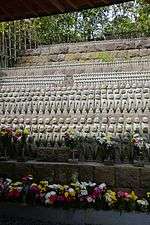Hase-dera (Kamakura)
Hase-dera (海光山慈照院長谷寺, Kaikō-zan Jishō-in Hase-dera), commonly called the Hase-kannon (長谷観音) is one of the Buddhist temples in the city of Kamakura in Kanagawa Prefecture, Japan, famous for housing a massive wooden statue of Kannon.
| Hase-dera | |
|---|---|
 Kannon-dō (Main hall) | |
| Religion | |
| Affiliation | Jōdo-shū |
| Deity | Jūichimen Kannon (Eleven-Headed Kannon) |
| Location | |
| Location | 3-11-2 Hase, Kamakura, Kanagawa Prefecture |
| Country | Japan |
| Architecture | |
| Founder | Tokudō Shōnin |
| Completed | 736 |
| Website | |
| http://www.hasedera.jp | |
The temple originally belonged to the Tendai sect of Buddhism, but eventually became an independent temple of the Jōdo-shū.[1]
History
Legend has it that the temple was established in the Tenpyō era (729-749 C.E.). However, documents at the temple suggest that the temple really came into its own during the Kamakura period (1192-1333).
Statue
The main statue of Kannon is one of the largest wooden statues in Japan, with a height of 9.18 metres (30.1 ft), and is made from camphor wood and gilded in gold. It has 11 heads, each of which represents a different phase in the search for enlightenment.
According to legend, the statue is one of two images of Kannon carved by a monk named Tokudō in 721.[1] The camphor tree was so large, according to legend, that he decided that he could carve two statues with it. One was enshrined in Hase-dera in the city of Nara, Yamato Province, while the other was set adrift in the sea to find the place with which it had a karmic connection. The statue washed ashore on Nagai Beach on the Miura Peninsula near Kamakura in the year 736. The statue was immediately brought to Kamakura where a temple was built to honor it.
Temple buildings
The temple sits about half-way up Mount Kamakura, southwest of the city of Kamakura. The temple commands an impressive view over Yuigahama.
Seven buildings make up the temple complex.
Temple grounds
The temple is built on two levels and also includes a cave. The cave, called benten kutsu (Benzaiten Grotto), contains a long winding tunnel with a low ceiling and various statues and devotionals to Benzaiten, the sea goddess and the only female of the Seven Lucky Gods in Japanese mythology.
The temple is famous for its hydrangeas, which bloom along the Hydrangea Path in June and July.

The grounds of the temple are home to hundreds of small Jizō statues, placed by parents mourning offspring lost to miscarriage, stillbirth, or abortion. These statues remain in place for about a year, before being removed to make way for more statues; it is estimated that some 50,000 Jizō statues have been placed at Hase-dera since World War II.[2]
Pilgrimage routes
The temple is the fourth of the 33 stations of two different pilgrimage routes:
1) Bandō Sanjūsankasho pilgrimage circuit dedicated to the goddess Benzaiten.
Gallery
 Sanmon (main gate)
Sanmon (main gate)- Amida-do
- Kakigara-Inari
- View over Kamakura's Sagami Bay
- Kyōzō (Sutra Archive)
- Daikoku-do
Benten-Kutsu Cave
 Entrance to the cave
Entrance to the cave- Statues of Benten
- Bas-relief of Gyūba-dōji
- Different Buddhist deities
See also
- For an explanation of terms concerning Japanese Buddhism, Japanese Buddhist art, and Japanese Buddhist temple architecture, see the Glossary of Japanese Buddhism.
References
| Wikimedia Commons has media related to Hasedera (Kamakura). |
- English language pamphlet from Kaikozan Hasedera
- http://www.sacred-destinations.com/japan/kamakura-hasedera
- Kannon - Goddess of Mercy--Pilgrimage in Japan
External links
- Hasedera
- Kamakura Trip website "Hasedera Temple(Hase Kannon)" page (in English)